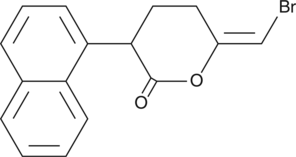Cayman
Showing 12601–12750 of 45550 results
-
Brivanib is an ATP-competitive inhibitor of human vascular endothelial growth factor receptors (VEGFRs) 1 and 2 and fibroblast growth factor receptor 1 (FGFR1; IC50s = 380, 25, and 148 nM, respectively, for the human recombinant proteins).{36328} It is selective for VEGFR1 and 2 and FGFR1 over PDGFRβ, EGFR, LCK, PKCα, and JAK3 (IC50s = >1,900 nM), however, it also inhibits recombinant mouse Flk1 with an IC50 value of 89 nM. In vitro, brivanib inhibits VEGF- and FGF-stimulated proliferation of human umbilical vein endothelial cells (HUVECs) with IC50 values of 40 and 276 nM, respectively. In vivo, brivanib inhibits tumor growth by 85% and 97% when administered at 60 and 90 mg/kg p.o., respectively, for 10 days in an H3396 breast cancer mouse xenograft model. Brivanib (25 mg/kg per day for 7 days, p.o.) inhibits bile duct ligation-induced liver fibrosis in mice and increases expression of PDGFβ, PDGFRβ, TGF-β1, TGF-β R2, FGF2, FGFR2, and VEGFR2 mRNAs.{36329}
Brand:CaymanSKU:23690 - 10 mgAvailable on backorder
Brivanib is an ATP-competitive inhibitor of human vascular endothelial growth factor receptors (VEGFRs) 1 and 2 and fibroblast growth factor receptor 1 (FGFR1; IC50s = 380, 25, and 148 nM, respectively, for the human recombinant proteins).{36328} It is selective for VEGFR1 and 2 and FGFR1 over PDGFRβ, EGFR, LCK, PKCα, and JAK3 (IC50s = >1,900 nM), however, it also inhibits recombinant mouse Flk1 with an IC50 value of 89 nM. In vitro, brivanib inhibits VEGF- and FGF-stimulated proliferation of human umbilical vein endothelial cells (HUVECs) with IC50 values of 40 and 276 nM, respectively. In vivo, brivanib inhibits tumor growth by 85% and 97% when administered at 60 and 90 mg/kg p.o., respectively, for 10 days in an H3396 breast cancer mouse xenograft model. Brivanib (25 mg/kg per day for 7 days, p.o.) inhibits bile duct ligation-induced liver fibrosis in mice and increases expression of PDGFβ, PDGFRβ, TGF-β1, TGF-β R2, FGF2, FGFR2, and VEGFR2 mRNAs.{36329}
Brand:CaymanSKU:23690 - 25 mgAvailable on backorder
Brivanib is an ATP-competitive inhibitor of human vascular endothelial growth factor receptors (VEGFRs) 1 and 2 and fibroblast growth factor receptor 1 (FGFR1; IC50s = 380, 25, and 148 nM, respectively, for the human recombinant proteins).{36328} It is selective for VEGFR1 and 2 and FGFR1 over PDGFRβ, EGFR, LCK, PKCα, and JAK3 (IC50s = >1,900 nM), however, it also inhibits recombinant mouse Flk1 with an IC50 value of 89 nM. In vitro, brivanib inhibits VEGF- and FGF-stimulated proliferation of human umbilical vein endothelial cells (HUVECs) with IC50 values of 40 and 276 nM, respectively. In vivo, brivanib inhibits tumor growth by 85% and 97% when administered at 60 and 90 mg/kg p.o., respectively, for 10 days in an H3396 breast cancer mouse xenograft model. Brivanib (25 mg/kg per day for 7 days, p.o.) inhibits bile duct ligation-induced liver fibrosis in mice and increases expression of PDGFβ, PDGFRβ, TGF-β1, TGF-β R2, FGF2, FGFR2, and VEGFR2 mRNAs.{36329}
Brand:CaymanSKU:23690 - 5 mgAvailable on backorder
Brivanib alaninate is the L-alanine prodrug form of brivanib (Item No. 23690), a VEGF receptor 2 (VEGFR2) and FGF receptor 1 (FGFR1) inhibitor.{36328,47106} Brivanib alaninate (3 mg/kg per day) reduces hepatic angiogenesis and VEGF, TGF-β1, CD31, and phosphorylated VEGFR2 and FGFR levels in a bile duct-ligated rat model of cirrhosis.{47107} It reduces tumor growth in an L2987 non-small cell lung cancer mouse xenograft model, exhibiting 97% tumor growth inhibition when administered at a dose of 107 mg/kg.{47106}
Brand:CaymanSKU:26081 - 10 mgAvailable on backorder
Brivanib alaninate is the L-alanine prodrug form of brivanib (Item No. 23690), a VEGF receptor 2 (VEGFR2) and FGF receptor 1 (FGFR1) inhibitor.{36328,47106} Brivanib alaninate (3 mg/kg per day) reduces hepatic angiogenesis and VEGF, TGF-β1, CD31, and phosphorylated VEGFR2 and FGFR levels in a bile duct-ligated rat model of cirrhosis.{47107} It reduces tumor growth in an L2987 non-small cell lung cancer mouse xenograft model, exhibiting 97% tumor growth inhibition when administered at a dose of 107 mg/kg.{47106}
Brand:CaymanSKU:26081 - 25 mgAvailable on backorder
Brivanib alaninate is the L-alanine prodrug form of brivanib (Item No. 23690), a VEGF receptor 2 (VEGFR2) and FGF receptor 1 (FGFR1) inhibitor.{36328,47106} Brivanib alaninate (3 mg/kg per day) reduces hepatic angiogenesis and VEGF, TGF-β1, CD31, and phosphorylated VEGFR2 and FGFR levels in a bile duct-ligated rat model of cirrhosis.{47107} It reduces tumor growth in an L2987 non-small cell lung cancer mouse xenograft model, exhibiting 97% tumor growth inhibition when administered at a dose of 107 mg/kg.{47106}
Brand:CaymanSKU:26081 - 5 mgAvailable on backorder
Brivanib alaninate is the L-alanine prodrug form of brivanib (Item No. 23690), a VEGF receptor 2 (VEGFR2) and FGF receptor 1 (FGFR1) inhibitor.{36328,47106} Brivanib alaninate (3 mg/kg per day) reduces hepatic angiogenesis and VEGF, TGF-β1, CD31, and phosphorylated VEGFR2 and FGFR levels in a bile duct-ligated rat model of cirrhosis.{47107} It reduces tumor growth in an L2987 non-small cell lung cancer mouse xenograft model, exhibiting 97% tumor growth inhibition when administered at a dose of 107 mg/kg.{47106}
Brand:CaymanSKU:26081 - 50 mgAvailable on backorder
Brivudine is a thymidine analog and inhibitor of herpes simplex virus 1 (HSV-1) and varicella-zoster virus (VZV) viral replication.{42575,53248} Following conversion to a 5′-triphosphate form by viral kinases, brivudine is incorporated into viral DNA, inhibiting viral DNA polymerases and inducing strand breakage.{53248} Brivudine (0.02-0.04 μg/ml) inhibits VZV replication in primary human fibroblasts and inhibits cytopathogenic effects of the KOS HSV-1 strain in a panel of cell lines (MIC50s = 0.007-0.4 μg/ml).{42575,53249} It selectively inhibits cytopathogenicity induced by HSV-1 strains over HSV-2, vaccinia virus, vesicular stomatitis virus, or deoxythymidine kinase-deficient HSV-1 strains in E6SM cells (MIC50s = 0.02, 2-10, 7, >400, and 40 μg/ml, respectively).{42575} Brivudine (5 and 15 mg/kg twice per day) increases survival in a mouse model of disseminated HSV-1 infection.
Brand:CaymanSKU:29448 - 1 gAvailable on backorder
Brivudine is a thymidine analog and inhibitor of herpes simplex virus 1 (HSV-1) and varicella-zoster virus (VZV) viral replication.{42575,53248} Following conversion to a 5′-triphosphate form by viral kinases, brivudine is incorporated into viral DNA, inhibiting viral DNA polymerases and inducing strand breakage.{53248} Brivudine (0.02-0.04 μg/ml) inhibits VZV replication in primary human fibroblasts and inhibits cytopathogenic effects of the KOS HSV-1 strain in a panel of cell lines (MIC50s = 0.007-0.4 μg/ml).{42575,53249} It selectively inhibits cytopathogenicity induced by HSV-1 strains over HSV-2, vaccinia virus, vesicular stomatitis virus, or deoxythymidine kinase-deficient HSV-1 strains in E6SM cells (MIC50s = 0.02, 2-10, 7, >400, and 40 μg/ml, respectively).{42575} Brivudine (5 and 15 mg/kg twice per day) increases survival in a mouse model of disseminated HSV-1 infection.
Brand:CaymanSKU:29448 - 100 mgAvailable on backorder
Brivudine is a thymidine analog and inhibitor of herpes simplex virus 1 (HSV-1) and varicella-zoster virus (VZV) viral replication.{42575,53248} Following conversion to a 5′-triphosphate form by viral kinases, brivudine is incorporated into viral DNA, inhibiting viral DNA polymerases and inducing strand breakage.{53248} Brivudine (0.02-0.04 μg/ml) inhibits VZV replication in primary human fibroblasts and inhibits cytopathogenic effects of the KOS HSV-1 strain in a panel of cell lines (MIC50s = 0.007-0.4 μg/ml).{42575,53249} It selectively inhibits cytopathogenicity induced by HSV-1 strains over HSV-2, vaccinia virus, vesicular stomatitis virus, or deoxythymidine kinase-deficient HSV-1 strains in E6SM cells (MIC50s = 0.02, 2-10, 7, >400, and 40 μg/ml, respectively).{42575} Brivudine (5 and 15 mg/kg twice per day) increases survival in a mouse model of disseminated HSV-1 infection.
Brand:CaymanSKU:29448 - 250 mgAvailable on backorder
Brivudine is a thymidine analog and inhibitor of herpes simplex virus 1 (HSV-1) and varicella-zoster virus (VZV) viral replication.{42575,53248} Following conversion to a 5′-triphosphate form by viral kinases, brivudine is incorporated into viral DNA, inhibiting viral DNA polymerases and inducing strand breakage.{53248} Brivudine (0.02-0.04 μg/ml) inhibits VZV replication in primary human fibroblasts and inhibits cytopathogenic effects of the KOS HSV-1 strain in a panel of cell lines (MIC50s = 0.007-0.4 μg/ml).{42575,53249} It selectively inhibits cytopathogenicity induced by HSV-1 strains over HSV-2, vaccinia virus, vesicular stomatitis virus, or deoxythymidine kinase-deficient HSV-1 strains in E6SM cells (MIC50s = 0.02, 2-10, 7, >400, and 40 μg/ml, respectively).{42575} Brivudine (5 and 15 mg/kg twice per day) increases survival in a mouse model of disseminated HSV-1 infection.
Brand:CaymanSKU:29448 - 500 mgAvailable on backorder
BRL 15572 is an antagonist of the serotonin (5-HT) receptor subtype 5-HT1D (Ki = 0.013 µM in CHO cell membranes expressing the human receptor).{54405} It is selective for 5-HT1D over several other G protein-coupled 5-HT receptor subtypes with Ki values ranging from 0.25 to 6.3 µM but does bind 5-HT1A and 5-HT2B receptors (Kis = 0.02 and 0.04 µM, respectively). BRL 15572 also acts as a partial agonist at 5-HT1D receptors (EC50 = 0.008 µM in a [35S]GTPγS binding assay).
Brand:CaymanSKU:31191 - 10 mgAvailable on backorder
BRL 15572 is an antagonist of the serotonin (5-HT) receptor subtype 5-HT1D (Ki = 0.013 µM in CHO cell membranes expressing the human receptor).{54405} It is selective for 5-HT1D over several other G protein-coupled 5-HT receptor subtypes with Ki values ranging from 0.25 to 6.3 µM but does bind 5-HT1A and 5-HT2B receptors (Kis = 0.02 and 0.04 µM, respectively). BRL 15572 also acts as a partial agonist at 5-HT1D receptors (EC50 = 0.008 µM in a [35S]GTPγS binding assay).
Brand:CaymanSKU:31191 - 100 mgAvailable on backorder
BRL 15572 is an antagonist of the serotonin (5-HT) receptor subtype 5-HT1D (Ki = 0.013 µM in CHO cell membranes expressing the human receptor).{54405} It is selective for 5-HT1D over several other G protein-coupled 5-HT receptor subtypes with Ki values ranging from 0.25 to 6.3 µM but does bind 5-HT1A and 5-HT2B receptors (Kis = 0.02 and 0.04 µM, respectively). BRL 15572 also acts as a partial agonist at 5-HT1D receptors (EC50 = 0.008 µM in a [35S]GTPγS binding assay).
Brand:CaymanSKU:31191 - 5 mgAvailable on backorder
BRL 15572 is an antagonist of the serotonin (5-HT) receptor subtype 5-HT1D (Ki = 0.013 µM in CHO cell membranes expressing the human receptor).{54405} It is selective for 5-HT1D over several other G protein-coupled 5-HT receptor subtypes with Ki values ranging from 0.25 to 6.3 µM but does bind 5-HT1A and 5-HT2B receptors (Kis = 0.02 and 0.04 µM, respectively). BRL 15572 also acts as a partial agonist at 5-HT1D receptors (EC50 = 0.008 µM in a [35S]GTPγS binding assay).
Brand:CaymanSKU:31191 - 50 mgAvailable on backorder
BRL 37344 is a selective agonist of β3-adrenergic receptors with Ki values of 0.43, 9.17, and 37.9 µM for β3, β2, and β1, respectively.{25395} β3-Adrenoceptors are expressed in adipose tissue as well as endothelial and myocardial tissues.{30103} This compound has been used to explore the role of these receptors in the regulation of thermogenesis and lipolysis and to modulate cardiac function in models of cardiovascular disease.{30104} It has also been used in rodents to study the role that β3-adrenergic receptors play in regulating anxiety-like behaviors.{30102}
Brand:CaymanSKU:-Available on backorder
BRL 37344 is a selective agonist of β3-adrenergic receptors with Ki values of 0.43, 9.17, and 37.9 µM for β3, β2, and β1, respectively.{25395} β3-Adrenoceptors are expressed in adipose tissue as well as endothelial and myocardial tissues.{30103} This compound has been used to explore the role of these receptors in the regulation of thermogenesis and lipolysis and to modulate cardiac function in models of cardiovascular disease.{30104} It has also been used in rodents to study the role that β3-adrenergic receptors play in regulating anxiety-like behaviors.{30102}
Brand:CaymanSKU:-Available on backorder
BRL 37344 is a selective agonist of β3-adrenergic receptors with Ki values of 0.43, 9.17, and 37.9 µM for β3, β2, and β1, respectively.{25395} β3-Adrenoceptors are expressed in adipose tissue as well as endothelial and myocardial tissues.{30103} This compound has been used to explore the role of these receptors in the regulation of thermogenesis and lipolysis and to modulate cardiac function in models of cardiovascular disease.{30104} It has also been used in rodents to study the role that β3-adrenergic receptors play in regulating anxiety-like behaviors.{30102}
Brand:CaymanSKU:-Available on backorder
BRL 37344 is a selective agonist of β3-adrenergic receptors with Ki values of 0.43, 9.17, and 37.9 µM for β3, β2, and β1, respectively.{25395} β3-Adrenoceptors are expressed in adipose tissue as well as endothelial and myocardial tissues.{30103} This compound has been used to explore the role of these receptors in the regulation of thermogenesis and lipolysis and to modulate cardiac function in models of cardiovascular disease.{30104} It has also been used in rodents to study the role that β3-adrenergic receptors play in regulating anxiety-like behaviors.{30102}
Brand:CaymanSKU:-Available on backorder
BRL 44408 is an antagonist of α2A-adrenergic receptors (α2A-ARs; Ki = 8.56 nM for the recombinant human receptors).{45714} It is greater than 50-fold selective for α2A-ARs over α1-, α2B-, α2C-, β1-, and β2-ARs, as well as 19 other neurotransmitter receptors, transporters, and enzymes in a panel at 1 µM. BRL 44408 inhibits forskolin-stimulated cAMP accumulation with an IC50 value of 92.3 nM in CHO cells expressing the recombinant human α2A-AR. It increases norepinephrine and dopamine levels by 200 and 100%, respectively, in rat medial prefrontal cortex when administered at a dose of 10 mg/kg. BRL 44408 (10 and 30 mg/kg) decreases the time rats spend immobile in the forced swim test, indicating antidepressant-like activity, and reduces para-phenylquinone-induced abdominal stretching, indicating analgesic activity, in rats.
Brand:CaymanSKU:29454 - 10 mgAvailable on backorder
BRL 44408 is an antagonist of α2A-adrenergic receptors (α2A-ARs; Ki = 8.56 nM for the recombinant human receptors).{45714} It is greater than 50-fold selective for α2A-ARs over α1-, α2B-, α2C-, β1-, and β2-ARs, as well as 19 other neurotransmitter receptors, transporters, and enzymes in a panel at 1 µM. BRL 44408 inhibits forskolin-stimulated cAMP accumulation with an IC50 value of 92.3 nM in CHO cells expressing the recombinant human α2A-AR. It increases norepinephrine and dopamine levels by 200 and 100%, respectively, in rat medial prefrontal cortex when administered at a dose of 10 mg/kg. BRL 44408 (10 and 30 mg/kg) decreases the time rats spend immobile in the forced swim test, indicating antidepressant-like activity, and reduces para-phenylquinone-induced abdominal stretching, indicating analgesic activity, in rats.
Brand:CaymanSKU:29454 - 25 mgAvailable on backorder
BRL 44408 is an antagonist of α2A-adrenergic receptors (α2A-ARs; Ki = 8.56 nM for the recombinant human receptors).{45714} It is greater than 50-fold selective for α2A-ARs over α1-, α2B-, α2C-, β1-, and β2-ARs, as well as 19 other neurotransmitter receptors, transporters, and enzymes in a panel at 1 µM. BRL 44408 inhibits forskolin-stimulated cAMP accumulation with an IC50 value of 92.3 nM in CHO cells expressing the recombinant human α2A-AR. It increases norepinephrine and dopamine levels by 200 and 100%, respectively, in rat medial prefrontal cortex when administered at a dose of 10 mg/kg. BRL 44408 (10 and 30 mg/kg) decreases the time rats spend immobile in the forced swim test, indicating antidepressant-like activity, and reduces para-phenylquinone-induced abdominal stretching, indicating analgesic activity, in rats.
Brand:CaymanSKU:29454 - 5 mgAvailable on backorder
BRL 50481 is a potent, selective inhibitor of phosphodiesterase (PDE) 7, inhibiting human recombinant PDE7A1 with a Ki value of 180 nM.{27633} It is much less effective against PDE3 and PDE4 and is without effect against PDE1B, PDE1C, PDE2, and PDE5.{27633} Through its effects on PDE7A1, BRL 50481 enhances the inhibitory effects of the PDE4 blocker rolipram (Item No. 10011132) on monocytes, lung macrophages, and CD8+ T-lymphocytes.{27633} BRL 50481, at 30 µM, promotes apoptosis in chronic lymphocytic leukemia cells overexpressing PDE7B, suggesting that this compound also acts against PDE7B.{27635} BRL 50481 can be used to evaluate the role of PDE7 isoforms in intracellular signaling.{27634}
Brand:CaymanSKU:-Out of stock
BRL 50481 is a potent, selective inhibitor of phosphodiesterase (PDE) 7, inhibiting human recombinant PDE7A1 with a Ki value of 180 nM.{27633} It is much less effective against PDE3 and PDE4 and is without effect against PDE1B, PDE1C, PDE2, and PDE5.{27633} Through its effects on PDE7A1, BRL 50481 enhances the inhibitory effects of the PDE4 blocker rolipram (Item No. 10011132) on monocytes, lung macrophages, and CD8+ T-lymphocytes.{27633} BRL 50481, at 30 µM, promotes apoptosis in chronic lymphocytic leukemia cells overexpressing PDE7B, suggesting that this compound also acts against PDE7B.{27635} BRL 50481 can be used to evaluate the role of PDE7 isoforms in intracellular signaling.{27634}
Brand:CaymanSKU:-Out of stock
BRL 50481 is a potent, selective inhibitor of phosphodiesterase (PDE) 7, inhibiting human recombinant PDE7A1 with a Ki value of 180 nM.{27633} It is much less effective against PDE3 and PDE4 and is without effect against PDE1B, PDE1C, PDE2, and PDE5.{27633} Through its effects on PDE7A1, BRL 50481 enhances the inhibitory effects of the PDE4 blocker rolipram (Item No. 10011132) on monocytes, lung macrophages, and CD8+ T-lymphocytes.{27633} BRL 50481, at 30 µM, promotes apoptosis in chronic lymphocytic leukemia cells overexpressing PDE7B, suggesting that this compound also acts against PDE7B.{27635} BRL 50481 can be used to evaluate the role of PDE7 isoforms in intracellular signaling.{27634}
Brand:CaymanSKU:-Out of stock
BRL 50481 is a potent, selective inhibitor of phosphodiesterase (PDE) 7, inhibiting human recombinant PDE7A1 with a Ki value of 180 nM.{27633} It is much less effective against PDE3 and PDE4 and is without effect against PDE1B, PDE1C, PDE2, and PDE5.{27633} Through its effects on PDE7A1, BRL 50481 enhances the inhibitory effects of the PDE4 blocker rolipram (Item No. 10011132) on monocytes, lung macrophages, and CD8+ T-lymphocytes.{27633} BRL 50481, at 30 µM, promotes apoptosis in chronic lymphocytic leukemia cells overexpressing PDE7B, suggesting that this compound also acts against PDE7B.{27635} BRL 50481 can be used to evaluate the role of PDE7 isoforms in intracellular signaling.{27634}
Brand:CaymanSKU:-Out of stock
BRL 54443 is a potent agonist of the serotonin (5-HT) receptor subtypes 5-HT1E and 5-HT1F (Ki values are 1.1 and 0.7 nM, respectively).{33346} It displays more than 30-fold selectivity over other 5-HT and dopamine receptors. At higher concentrations, BRL 54443 induces 5-HT2A-mediated contraction of mouse thoracic aorta strips in vitro (pEC50 = 6.5).{33347} It significantly reduces formalin-induced pain in rat hind paw.{33345}
Brand:CaymanSKU:21263 -Out of stock
BRL 54443 is a potent agonist of the serotonin (5-HT) receptor subtypes 5-HT1E and 5-HT1F (Ki values are 1.1 and 0.7 nM, respectively).{33346} It displays more than 30-fold selectivity over other 5-HT and dopamine receptors. At higher concentrations, BRL 54443 induces 5-HT2A-mediated contraction of mouse thoracic aorta strips in vitro (pEC50 = 6.5).{33347} It significantly reduces formalin-induced pain in rat hind paw.{33345}
Brand:CaymanSKU:21263 -Out of stock
BRL 54443 is a potent agonist of the serotonin (5-HT) receptor subtypes 5-HT1E and 5-HT1F (Ki values are 1.1 and 0.7 nM, respectively).{33346} It displays more than 30-fold selectivity over other 5-HT and dopamine receptors. At higher concentrations, BRL 54443 induces 5-HT2A-mediated contraction of mouse thoracic aorta strips in vitro (pEC50 = 6.5).{33347} It significantly reduces formalin-induced pain in rat hind paw.{33345}
Brand:CaymanSKU:21263 -Out of stock
BRL 54443 is a potent agonist of the serotonin (5-HT) receptor subtypes 5-HT1E and 5-HT1F (Ki values are 1.1 and 0.7 nM, respectively).{33346} It displays more than 30-fold selectivity over other 5-HT and dopamine receptors. At higher concentrations, BRL 54443 induces 5-HT2A-mediated contraction of mouse thoracic aorta strips in vitro (pEC50 = 6.5).{33347} It significantly reduces formalin-induced pain in rat hind paw.{33345}
Brand:CaymanSKU:21263 -Out of stock
Bromacil is a phytotoxic herbicide that inhibits growth of watermelon, molokhia, and wheat plants (EC50s = 4.77, 0.08, and 3.08 mg/kg of soil, respectively).{42203} It inhibits growth of mustard, pea, sugar beet, linseed, barley, maize, ryegrass, and buckwheat plants by greater than 90% when used at a concentration of 1 kg/hectare.{42204} In vivo, bromacil induces formation of thyroid tumors in rats and liver tumors in mice.{42197}
Brand:CaymanSKU:24136 - 100 mgAvailable on backorder
Bromadiolone is a second generation anticoagulant rodenticide and 4-hydroxycoumarin derivative.{45454,45455} It is an inhibitor of vitamin K epoxide reductase (VKOR) that inhibits blood clotting. It inhibits human VKOR complex subunit 1 (VKORC1) with an IC50 value of 1.6 nM in a cell-based assay.{45456} Bromadiolone is toxic to rodents, including mice (LD50 = 1.75 mg/kg) and rats (LD50s = 1.05 and 1.83 mg/kg for males and females, respectively).{45461,45462} It does not significantly affect breeding performance in mice when administered at a dose of up to 70% of the LD50 value.{45463} Resistance to bromadiolone is conferred by mutations to the VKOR gene, Vkorc1.{45464} Formulations containing bromadiolone have been used in the control of rodent pest populations.
Brand:CaymanSKU:26854 - 100 mgAvailable on backorder
Bromadiolone is a second generation anticoagulant rodenticide and 4-hydroxycoumarin derivative.{45454,45455} It is an inhibitor of vitamin K epoxide reductase (VKOR) that inhibits blood clotting. It inhibits human VKOR complex subunit 1 (VKORC1) with an IC50 value of 1.6 nM in a cell-based assay.{45456} Bromadiolone is toxic to rodents, including mice (LD50 = 1.75 mg/kg) and rats (LD50s = 1.05 and 1.83 mg/kg for males and females, respectively).{45461,45462} It does not significantly affect breeding performance in mice when administered at a dose of up to 70% of the LD50 value.{45463} Resistance to bromadiolone is conferred by mutations to the VKOR gene, Vkorc1.{45464} Formulations containing bromadiolone have been used in the control of rodent pest populations.
Brand:CaymanSKU:26854 - 50 mgAvailable on backorder
Bromamphenicol is a dibrominated derivative of the antibiotic chloramphenicol.{42777} It inhibits rat liver mitochondrial and E. coli protein synthesis by 90.6 and 98.8%, respectively, when used at a concentration of 93 μM, and inhibits DNA synthesis in human lymphoblastoid cells by 83% at 1 mM. Bromamphenicol can also bind to the major adhesin subunit DraE from E. coli.{42778}
Brand:CaymanSKU:28016 - 25 mgAvailable on backorder
Bromamphenicol is a dibrominated derivative of the antibiotic chloramphenicol.{42777} It inhibits rat liver mitochondrial and E. coli protein synthesis by 90.6 and 98.8%, respectively, when used at a concentration of 93 μM, and inhibits DNA synthesis in human lymphoblastoid cells by 83% at 1 mM. Bromamphenicol can also bind to the major adhesin subunit DraE from E. coli.{42778}
Brand:CaymanSKU:28016 - 5 mgAvailable on backorder
Bromantane (Item No. 24688) is an analytical reference standard categorized as a stimulant.{41806} Stimulants, including bromantane, have been used to enhance physical performance in athletes. This product is intended for research and forensic applications.
Brand:CaymanSKU:24688 - 10 mgAvailable on backorder
Bromantane (Item No. 24688) is an analytical reference standard categorized as a stimulant.{41806} Stimulants, including bromantane, have been used to enhance physical performance in athletes. This product is intended for research and forensic applications.
Brand:CaymanSKU:24688 - 25 mgAvailable on backorder
Bromazolam (Item No. 22665) is an analytical reference standard categorized as a benzodiazepine. This product is intended for research and forensic applications.
Brand:CaymanSKU:22665 -Out of stock
Bromazolam (Item No. 22665) is an analytical reference standard categorized as a benzodiazepine. This product is intended for research and forensic applications.
Brand:CaymanSKU:22665 -Out of stock
Bromelain is a mixture of proteolytic enzymes and non-protease components (phosphatases, glucosidases, peroxidases, cellulases, glycoproteins, and carbohydrates) derived from the stem and fruit of pineapple plants.{30808,30809} Bromelain has been studied for a number of potentially beneficial effects, including anti-inflammatory, anti-thrombotic, fibrinolytic, and anti-cancer functions.{30808,30809}
Brand:CaymanSKU:-Available on backorder
Bromelain is a mixture of proteolytic enzymes and non-protease components (phosphatases, glucosidases, peroxidases, cellulases, glycoproteins, and carbohydrates) derived from the stem and fruit of pineapple plants.{30808,30809} Bromelain has been studied for a number of potentially beneficial effects, including anti-inflammatory, anti-thrombotic, fibrinolytic, and anti-cancer functions.{30808,30809}
Brand:CaymanSKU:-Available on backorder
Bromelain is a mixture of proteolytic enzymes and non-protease components (phosphatases, glucosidases, peroxidases, cellulases, glycoproteins, and carbohydrates) derived from the stem and fruit of pineapple plants.{30808,30809} Bromelain has been studied for a number of potentially beneficial effects, including anti-inflammatory, anti-thrombotic, fibrinolytic, and anti-cancer functions.{30808,30809}
Brand:CaymanSKU:-Available on backorder
Bromelain is a mixture of proteolytic enzymes and non-protease components (phosphatases, glucosidases, peroxidases, cellulases, glycoproteins, and carbohydrates) derived from the stem and fruit of pineapple plants.{30808,30809} Bromelain has been studied for a number of potentially beneficial effects, including anti-inflammatory, anti-thrombotic, fibrinolytic, and anti-cancer functions.{30808,30809}
Brand:CaymanSKU:-Available on backorder
Bromfenac is an inhibitor of cyclooxygenase 2 (COX-2; IC50 = 6.6 nM) that is selective over COX-1 (IC50 = 210 nM).{39441} It inhibits prostaglandin E2 (PGE2; Item No. 14010) production in a rabbit model of LPS-induced eye inflammation. Bromfenac also decreases inflammation following cataract removal in dogs when administered as a 0.9% topical solution on a tapering schedule for 24 weeks.{39440} Formulations containing bromfenac have been used in the treatment of postoperative inflammation following cataract surgery.
Brand:CaymanSKU:23763 - 10 mgAvailable on backorder
Bromfenac is an inhibitor of cyclooxygenase 2 (COX-2; IC50 = 6.6 nM) that is selective over COX-1 (IC50 = 210 nM).{39441} It inhibits prostaglandin E2 (PGE2; Item No. 14010) production in a rabbit model of LPS-induced eye inflammation. Bromfenac also decreases inflammation following cataract removal in dogs when administered as a 0.9% topical solution on a tapering schedule for 24 weeks.{39440} Formulations containing bromfenac have been used in the treatment of postoperative inflammation following cataract surgery.
Brand:CaymanSKU:23763 - 50 mgAvailable on backorder
Bromo-DragonFLY is a difuran analog of the Schedule I hallucinogen 4-bromo-2,5-dimethoxyphenethylamine.{21377} This designer drug strongly binds serotonin receptors (Ki = 0.04, 0.19, and 0.02 nM for 5-HT2A, 5-HT2B, and 5-HT2C, respectively).{21685} It is more potent than LSD in drug discrimination studies in rats.{21685} Related to its high potency, Bromo-DragonFLY has been associated with fatalities as well as acute intoxications.{21684} GC-MS, GC-IRD, and solid phase FTIR spectra have been published.{21377} This product is intended for research and forensic purposes.
Brand:CaymanSKU:11561 - 1 mgAvailable on backorder
Bromo-DragonFLY is a difuran analog of the Schedule I hallucinogen 4-bromo-2,5-dimethoxyphenethylamine.{21377} This designer drug strongly binds serotonin receptors (Ki = 0.04, 0.19, and 0.02 nM for 5-HT2A, 5-HT2B, and 5-HT2C, respectively).{21685} It is more potent than LSD in drug discrimination studies in rats.{21685} Related to its high potency, Bromo-DragonFLY has been associated with fatalities as well as acute intoxications.{21684} GC-MS, GC-IRD, and solid phase FTIR spectra have been published.{21377} This product is intended for research and forensic purposes.
Brand:CaymanSKU:11561 - 10 mgAvailable on backorder
Bromo-DragonFLY is a difuran analog of the Schedule I hallucinogen 4-bromo-2,5-dimethoxyphenethylamine.{21377} This designer drug strongly binds serotonin receptors (Ki = 0.04, 0.19, and 0.02 nM for 5-HT2A, 5-HT2B, and 5-HT2C, respectively).{21685} It is more potent than LSD in drug discrimination studies in rats.{21685} Related to its high potency, Bromo-DragonFLY has been associated with fatalities as well as acute intoxications.{21684} GC-MS, GC-IRD, and solid phase FTIR spectra have been published.{21377} This product is intended for research and forensic purposes.
Brand:CaymanSKU:11561 - 5 mgAvailable on backorder
Bromoacetamido-PEG3-Boc-amine is a PEGylated linker that contains a tert-butyloxy carbonyl (Boc) protecting group.
Brand:CaymanSKU:30554 - 100 mgAvailable on backorder
Bromoacetamido-PEG3-Boc-amine is a PEGylated linker that contains a tert-butyloxy carbonyl (Boc) protecting group.
Brand:CaymanSKU:30554 - 250 mgAvailable on backorder
Bromoacetamido-PEG3-Boc-amine is a PEGylated linker that contains a tert-butyloxy carbonyl (Boc) protecting group.
Brand:CaymanSKU:30554 - 50 mgAvailable on backorder
Bromobenzene-13C6 is a building block.{56010,56011} It has been used in the synthesis of 13C6-labeled naphthalenes and polychlorinated biphenyls.
Brand:CaymanSKU:30524 - 1 gAvailable on backorder
Bromobenzene-13C6 is a building block.{56010,56011} It has been used in the synthesis of 13C6-labeled naphthalenes and polychlorinated biphenyls.
Brand:CaymanSKU:30524 - 100 mgAvailable on backorder
Bromobenzene-13C6 is a building block.{56010,56011} It has been used in the synthesis of 13C6-labeled naphthalenes and polychlorinated biphenyls.
Brand:CaymanSKU:30524 - 250 mgAvailable on backorder
Bromobenzene-13C6 is a building block.{56010,56011} It has been used in the synthesis of 13C6-labeled naphthalenes and polychlorinated biphenyls.
Brand:CaymanSKU:30524 - 500 mgAvailable on backorder
Bromocriptine is a dopamine receptor agonist (Kis = 1,659, 12.2, 12.2, 59.7, and 1,691 nM for dopamine D1, D2, D3, D4, and D5 receptors, respectively).{21784} It also binds to the serotonin (5-HT) receptor subtypes 5-HT1A and 5-HT1D (Kis = 12.9 and 10.7 nM, respectively), as well as α1-adrenergic receptors (Kis = 1.12-4.17 nM).{21784,21785} Bromocriptine (5 mg/kg) restores locomotor activity, without inducing dyskinesia, in a macaque model of Parkinson’s disease induced by MPTP.{53230} Formulations containing bromocriptine have been used in the treatment of Parkinson’s disease, hyperprolactinemia-associated dysfunctions, and acromegaly.
Brand:CaymanSKU:-Bromocriptine is a dopamine receptor agonist (Kis = 1,659, 12.2, 12.2, 59.7, and 1,691 nM for dopamine D1, D2, D3, D4, and D5 receptors, respectively).{21784} It also binds to the serotonin (5-HT) receptor subtypes 5-HT1A and 5-HT1D (Kis = 12.9 and 10.7 nM, respectively), as well as α1-adrenergic receptors (Kis = 1.12-4.17 nM).{21784,21785} Bromocriptine (5 mg/kg) restores locomotor activity, without inducing dyskinesia, in a macaque model of Parkinson’s disease induced by MPTP.{53230} Formulations containing bromocriptine have been used in the treatment of Parkinson’s disease, hyperprolactinemia-associated dysfunctions, and acromegaly.
Brand:CaymanSKU:-Bromocriptine is a dopamine receptor agonist (Kis = 1,659, 12.2, 12.2, 59.7, and 1,691 nM for dopamine D1, D2, D3, D4, and D5 receptors, respectively).{21784} It also binds to the serotonin (5-HT) receptor subtypes 5-HT1A and 5-HT1D (Kis = 12.9 and 10.7 nM, respectively), as well as α1-adrenergic receptors (Kis = 1.12-4.17 nM).{21784,21785} Bromocriptine (5 mg/kg) restores locomotor activity, without inducing dyskinesia, in a macaque model of Parkinson’s disease induced by MPTP.{53230} Formulations containing bromocriptine have been used in the treatment of Parkinson’s disease, hyperprolactinemia-associated dysfunctions, and acromegaly.
Brand:CaymanSKU:-Bromocriptine is a dopamine receptor agonist (Kis = 1,659, 12.2, 12.2, 59.7, and 1,691 nM for dopamine D1, D2, D3, D4, and D5 receptors, respectively).{21784} It also binds to the serotonin (5-HT) receptor subtypes 5-HT1A and 5-HT1D (Kis = 12.9 and 10.7 nM, respectively), as well as α1-adrenergic receptors (Kis = 1.12-4.17 nM).{21784,21785} Bromocriptine (5 mg/kg) restores locomotor activity, without inducing dyskinesia, in a macaque model of Parkinson’s disease induced by MPTP.{53230} Formulations containing bromocriptine have been used in the treatment of Parkinson’s disease, hyperprolactinemia-associated dysfunctions, and acromegaly.
Brand:CaymanSKU:-Bromodiphenhydramine is a histamine H1 receptor antagonist.{46620} It induces histamine release in isolated guinea pig lung when used at a concentration of 1 mM but completely prevents ovalbumin-induced histamine release in lungs isolated from ovalbumin-sensitized guinea pigs when used at concentrations of 100 and 200 µg/ml.{46621} Bromodiphenhydramine (17 mg/kg) inhibits formalin-induced paw edema in rats.{46620} It increases survival in a mouse model of systemic S. typhimurium infection when administered at doses of 1.5 and 3 mg/kg.{46622}
Brand:CaymanSKU:29636 - 10 mgAvailable on backorder
Bromodiphenhydramine is a histamine H1 receptor antagonist.{46620} It induces histamine release in isolated guinea pig lung when used at a concentration of 1 mM but completely prevents ovalbumin-induced histamine release in lungs isolated from ovalbumin-sensitized guinea pigs when used at concentrations of 100 and 200 µg/ml.{46621} Bromodiphenhydramine (17 mg/kg) inhibits formalin-induced paw edema in rats.{46620} It increases survival in a mouse model of systemic S. typhimurium infection when administered at doses of 1.5 and 3 mg/kg.{46622}
Brand:CaymanSKU:29636 - 25 mgAvailable on backorder
Bromodiphenhydramine is a histamine H1 receptor antagonist.{46620} It induces histamine release in isolated guinea pig lung when used at a concentration of 1 mM but completely prevents ovalbumin-induced histamine release in lungs isolated from ovalbumin-sensitized guinea pigs when used at concentrations of 100 and 200 µg/ml.{46621} Bromodiphenhydramine (17 mg/kg) inhibits formalin-induced paw edema in rats.{46620} It increases survival in a mouse model of systemic S. typhimurium infection when administered at doses of 1.5 and 3 mg/kg.{46622}
Brand:CaymanSKU:29636 - 5 mgAvailable on backorder
Bromodiphenhydramine is a histamine H1 receptor antagonist.{46620} It induces histamine release in isolated guinea pig lung when used at a concentration of 1 mM but completely prevents ovalbumin-induced histamine release in lungs isolated from ovalbumin-sensitized guinea pigs when used at concentrations of 100 and 200 µg/ml.{46621} Bromodiphenhydramine (17 mg/kg) inhibits formalin-induced paw edema in rats.{46620} It increases survival in a mouse model of systemic S. typhimurium infection when administered at doses of 1.5 and 3 mg/kg.{46622}
Brand:CaymanSKU:29636 - 50 mgAvailable on backorder
BEL is a selective, potent, irreversible, mechanism-based inhibitor of myocardial cytosolic calcium-independent phospholipase A2 (iPLA2) with a Ki value of 180 nM.{1631} BEL also inhibits macrophage iPLA2 in a concentration-dependent manner with an IC50 value of 60 nM and is an effective enzyme-activated irreversible inhibitor of chymotrypsin (Ki = 636 nM).{1291,1521}
Brand:CaymanSKU:70700 - 10 mgAvailable on backorder
BEL is a selective, potent, irreversible, mechanism-based inhibitor of myocardial cytosolic calcium-independent phospholipase A2 (iPLA2) with a Ki value of 180 nM.{1631} BEL also inhibits macrophage iPLA2 in a concentration-dependent manner with an IC50 value of 60 nM and is an effective enzyme-activated irreversible inhibitor of chymotrypsin (Ki = 636 nM).{1291,1521}
Brand:CaymanSKU:70700 - 25 mgAvailable on backorder
BEL is a selective, potent, irreversible, mechanism-based inhibitor of myocardial cytosolic calcium-independent phospholipase A2 (iPLA2) with a Ki value of 180 nM.{1631} BEL also inhibits macrophage iPLA2 in a concentration-dependent manner with an IC50 value of 60 nM and is an effective enzyme-activated irreversible inhibitor of chymotrypsin (Ki = 636 nM).{1291,1521}
Brand:CaymanSKU:70700 - 5 mgAvailable on backorder
BEL is a selective, potent, irreversible, mechanism-based inhibitor of myocardial cytosolic calcium-independent phospholipase A2 (iPLA2) with a Ki value of 180 nM.{1631} BEL also inhibits macrophage iPLA2 in a concentration-dependent manner with an IC50 value of 60 nM and is an effective enzyme-activated irreversible inhibitor of chymotrypsin (Ki = 636 nM).{1291,1521}
Brand:CaymanSKU:70700 - 50 mgAvailable on backorder
Brand:CaymanSKU:765038 - 1 eaAvailable on backorder
Bromophenol blue is commonly used as a pH indicator, a color marker to monitor the progress of agarose or polyacrylamide gel electrophoresis, and a dye to detect proteins and nucleic acids (absorbance at 610 nm), particularly when staining living tissues.{22795,22796,22797} As an acid-base indicator its useful pH range is 3-4.6 where the color changes from yellow at pH 3.0 to purple at pH 4.6.{22794}
Brand:CaymanSKU:-Bromophenol blue is commonly used as a pH indicator, a color marker to monitor the progress of agarose or polyacrylamide gel electrophoresis, and a dye to detect proteins and nucleic acids (absorbance at 610 nm), particularly when staining living tissues.{22795,22796,22797} As an acid-base indicator its useful pH range is 3-4.6 where the color changes from yellow at pH 3.0 to purple at pH 4.6.{22794}
Brand:CaymanSKU:-Bromophenol blue is commonly used as a pH indicator, a color marker to monitor the progress of agarose or polyacrylamide gel electrophoresis, and a dye to detect proteins and nucleic acids (absorbance at 610 nm), particularly when staining living tissues.{22795,22796,22797} As an acid-base indicator its useful pH range is 3-4.6 where the color changes from yellow at pH 3.0 to purple at pH 4.6.{22794}
Brand:CaymanSKU:-Bromopride is a dopamine D2 receptor antagonist (Ki = 14 nM).{46566} It binds to bovine anterior pituitary membranes with an IC50 value of 2.13 μM.{46567} Bromopride inhibits cholinesterase activity in vitro in rat plasma and striatum homogenate (IC50s = 67.8 and 38.4 μM, respectively).{46568} It increases serum prolactin levels in rats by 100% when used at a dose of 0.02 mol/kg.{46567} Bromopride (2.5 mg/kg) decreases locomotion and rearing in an open field test and impairs acquistion, but not retention, of a conditioned avoidance response in a two-way active conditioned avoidance test in rats.{46569}
Brand:CaymanSKU:29329 - 1 mgAvailable on backorder
Bromopride is a dopamine D2 receptor antagonist (Ki = 14 nM).{46566} It binds to bovine anterior pituitary membranes with an IC50 value of 2.13 μM.{46567} Bromopride inhibits cholinesterase activity in vitro in rat plasma and striatum homogenate (IC50s = 67.8 and 38.4 μM, respectively).{46568} It increases serum prolactin levels in rats by 100% when used at a dose of 0.02 mol/kg.{46567} Bromopride (2.5 mg/kg) decreases locomotion and rearing in an open field test and impairs acquistion, but not retention, of a conditioned avoidance response in a two-way active conditioned avoidance test in rats.{46569}
Brand:CaymanSKU:29329 - 10 mgAvailable on backorder
Bromopride is a dopamine D2 receptor antagonist (Ki = 14 nM).{46566} It binds to bovine anterior pituitary membranes with an IC50 value of 2.13 μM.{46567} Bromopride inhibits cholinesterase activity in vitro in rat plasma and striatum homogenate (IC50s = 67.8 and 38.4 μM, respectively).{46568} It increases serum prolactin levels in rats by 100% when used at a dose of 0.02 mol/kg.{46567} Bromopride (2.5 mg/kg) decreases locomotion and rearing in an open field test and impairs acquistion, but not retention, of a conditioned avoidance response in a two-way active conditioned avoidance test in rats.{46569}
Brand:CaymanSKU:29329 - 25 mgAvailable on backorder
Bromopride is a dopamine D2 receptor antagonist (Ki = 14 nM).{46566} It binds to bovine anterior pituitary membranes with an IC50 value of 2.13 μM.{46567} Bromopride inhibits cholinesterase activity in vitro in rat plasma and striatum homogenate (IC50s = 67.8 and 38.4 μM, respectively).{46568} It increases serum prolactin levels in rats by 100% when used at a dose of 0.02 mol/kg.{46567} Bromopride (2.5 mg/kg) decreases locomotion and rearing in an open field test and impairs acquistion, but not retention, of a conditioned avoidance response in a two-way active conditioned avoidance test in rats.{46569}
Brand:CaymanSKU:29329 - 5 mgAvailable on backorder
Bromodomains play a key role in many cellular processes, including inflammatory gene expression, mitosis, and viral/host interaction, by controlling the assembly of histone acetylation-dependent chromatin complexes. They serve as “readers” of histone acetylation marks, regulating the transcription of target promoters. For example, the cAMP response element-binding protein binding protein (CREBBP) bromodomain has been shown to modulate the stability and function of the tumor suppressor protein p53. Bromosporine is a non-selective bromodomain inhibitor. At 1 µM, it has been shown to accelerate fluorescence recovery after photobleaching (FRAP) recovery of BRD4 and CREBBP bromodomains in HeLa cells.{26201} This compound may be used in determining the biological roles of reader domains as well as a tool for the validation of functional assays. See the Structural Genomics Consortium (SGC) website for more information.
Brand:CaymanSKU:-Bromodomains play a key role in many cellular processes, including inflammatory gene expression, mitosis, and viral/host interaction, by controlling the assembly of histone acetylation-dependent chromatin complexes. They serve as “readers” of histone acetylation marks, regulating the transcription of target promoters. For example, the cAMP response element-binding protein binding protein (CREBBP) bromodomain has been shown to modulate the stability and function of the tumor suppressor protein p53. Bromosporine is a non-selective bromodomain inhibitor. At 1 µM, it has been shown to accelerate fluorescence recovery after photobleaching (FRAP) recovery of BRD4 and CREBBP bromodomains in HeLa cells.{26201} This compound may be used in determining the biological roles of reader domains as well as a tool for the validation of functional assays. See the Structural Genomics Consortium (SGC) website for more information.
Brand:CaymanSKU:-Bromodomains play a key role in many cellular processes, including inflammatory gene expression, mitosis, and viral/host interaction, by controlling the assembly of histone acetylation-dependent chromatin complexes. They serve as “readers” of histone acetylation marks, regulating the transcription of target promoters. For example, the cAMP response element-binding protein binding protein (CREBBP) bromodomain has been shown to modulate the stability and function of the tumor suppressor protein p53. Bromosporine is a non-selective bromodomain inhibitor. At 1 µM, it has been shown to accelerate fluorescence recovery after photobleaching (FRAP) recovery of BRD4 and CREBBP bromodomains in HeLa cells.{26201} This compound may be used in determining the biological roles of reader domains as well as a tool for the validation of functional assays. See the Structural Genomics Consortium (SGC) website for more information.
Brand:CaymanSKU:-Bromodomains play a key role in many cellular processes, including inflammatory gene expression, mitosis, and viral/host interaction, by controlling the assembly of histone acetylation-dependent chromatin complexes. They serve as “readers” of histone acetylation marks, regulating the transcription of target promoters. For example, the cAMP response element-binding protein binding protein (CREBBP) bromodomain has been shown to modulate the stability and function of the tumor suppressor protein p53. Bromosporine is a non-selective bromodomain inhibitor. At 1 µM, it has been shown to accelerate fluorescence recovery after photobleaching (FRAP) recovery of BRD4 and CREBBP bromodomains in HeLa cells.{26201} This compound may be used in determining the biological roles of reader domains as well as a tool for the validation of functional assays. See the Structural Genomics Consortium (SGC) website for more information.
Brand:CaymanSKU:-Bromosulfalein has been commonly used as both a substrate and inhibitor of organic anionic transporting polypeptide 1B1 (OATP1B1), OATP1B3, OATP1A2, and OATP2B1, as well as multidrug resistance protein 2 (MDR2).{36993,23995,23994,36994,36995,36996} It has also been used for in vivo studies of liver and biliary system function and as an anionic dye for the quantitative estimation of protein levels in tissue homogenates or purified samples.{36997,36998,36999}
Brand:CaymanSKU:21058 -Out of stock
Bromosulfalein has been commonly used as both a substrate and inhibitor of organic anionic transporting polypeptide 1B1 (OATP1B1), OATP1B3, OATP1A2, and OATP2B1, as well as multidrug resistance protein 2 (MDR2).{36993,23995,23994,36994,36995,36996} It has also been used for in vivo studies of liver and biliary system function and as an anionic dye for the quantitative estimation of protein levels in tissue homogenates or purified samples.{36997,36998,36999}
Brand:CaymanSKU:21058 -Out of stock
























